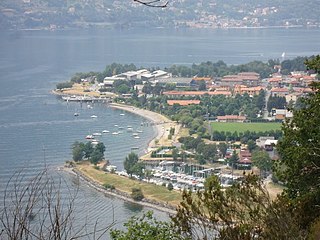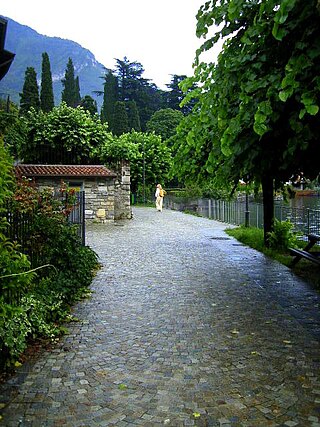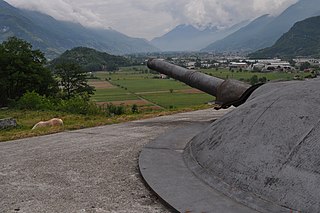
Lecco is a city of 48,131 inhabitants in Lombardy, northern Italy, 50 kilometres (31 mi) north of Milan. It lies at the end of the south-eastern branch of Lake Como. The Bergamo Alps rise to the north and east, cut through by the Valsassina of which Lecco marks the southern end.

Manerba del Garda is a town and comune in the province of Brescia, in Lombardy. It is located at the southwest side of the Lake Garda.

The Castello Sforzesco is a medieval fortification located in Milan, Northern Italy. It was built in the 15th century by Francesco Sforza, Duke of Milan, on the remnants of a 14th-century fortification. Later renovated and enlarged, in the 16th and 17th centuries it was one of the largest citadels in Europe. Extensively rebuilt by Luca Beltrami in 1891–1905, it now houses several of the city's museums and art collections.

Pedro Henriquez d'Azevedo y Alvarez de Toledo, Count of Fuentes de Valdepero was a Spanish general and statesman.

Colico is a town and comune in the province of Lecco, in Lombardy in northern Italy. It is situated on the northern arm of Lake Como, where the river Adda enters the lake. Colico is the largest town in the northern part of Lake Como, which is often identified as its Colico branch.
Musso is a small town in the Province of Como in the Italian region Lombardy. It lies on the western shore of the northern branch of Lake Como about 35 kilometres (22 mi) northeast of the city of Como. The comune of Musso, which includes the town itself and the surrounding area of lake and mountainside, extends over an area of 412 hectares, with a minimum elevation of 199 metres (653 ft) and a maximum of 1,325 metres (4,347 ft) and has a population of 1,020. It borders the communes of Dongo to the north, Pianello del Lario to the south and Colico across the lake in the Province of Lecco.

Airuno is a comune (municipality) in the Province of Lecco in the Italian region Lombardy, located about 35 kilometres (22 mi) northeast of Milan and about 11 kilometres (7 mi) south of Lecco. As of 31 December 2004, it had a population of 2,749 and an area of 4.3 square kilometres (1.7 sq mi).

Dervio is a comune (municipality) in the Province of Lecco in the Italian region Lombardy, located on the eastern shore of Lake Como, about 70 kilometres (43 mi) north of Milan and about 25 kilometres (16 mi) northwest of Lecco. It is located on a peninsula with same name on the Lake Como, at the mouth of the Varrone river Valley.

Lierna is a comune in the province of Lecco in Lombardy, in north-west Italy. It lies on the eastern shore of Lake Como, about 60 kilometres (37 mi) north of Milan and about 15 kilometres (9 mi) north-west of Lecco.

Molteno is a comune (municipality) and a hill-top town in the Province of Lecco in the Italian region Lombardy, located about 35 kilometres (22 mi) northeast of Milan and about 11 kilometres (7 mi) southwest of Lecco. As of 31 December 2004, it had a population of 3,206 and an area of 3.2 square kilometres (1.2 sq mi).

The Italian highway 36, Lake Como and Spluga is a major road in Lombardy. It provides the main access route to the Valtellina and the Swiss canton of Grisons from Milan and other cities in southern Lombardy.

The Fenestrelle Fortress, better known as the Fenestrelle Fort is a fortress overlooking Fenestrelle. It is the symbol of the Metropolitan City of Turin, Piedmont, northern Italy. It is the biggest alpine fortification in Europe, having a surface area of 1,300,000 m². The fortress, built by Savoy between 1728 and 1850 under the design of the architect Ignazio Bertola, guards the access to Turin via the Chisone valley and stands at altitudes between 1,100 and 1,800 m. The territory was acquired in 1709 by the Duchy of Savoy after the defeat of the French at Fort Mutin (Fenestrelle).

Fort Montecchio-Lusardi is a military fort situated in Colico, in the province of Lecco, northern Italy. It was built between 1911 and 1914.

Santa Maria in Calanca Castle is a tower in the municipality of Santa Maria in Calanca of the Canton of Graubünden in Switzerland. It, along with the neighboring Church of the Assumption of St. Mary, are both Swiss heritage sites of national significance.

The Cittadella of Alessandria is a star fort and citadel in the city of Alessandria, Italy. It was built in the 18th century by the Kingdom of Sardinia, and today it is one of the best preserved fortifications of that era. It is one of the few fortifications in Europe still in their original environment, since there are no buildings blocking the views of the ramparts, or a road that surrounds the ditches.

Forte del Santissimo Salvatore, also known as Castello del Santissimo Salvatore, is a fort in Messina, Sicily. It was built in the mid-16th century, and it is still military property. Some of its walls were demolished after the earthquake of 1908, but the rest of the fort is still intact.

The Exilles Fort is a fortified complex in the Susa Valley, Metropolitan City of Turin, Piedmont, northern Italy. Together with the nearby Fort of Fenestrelle and the Forte Albertino it was part of the defensive line between the House of Savoy lands and France: both these states held it in different phases depending on the outcome of the various wars. It is located on a spur commanding one of the narrowest sections of the Susa Valley, along the main road connecting Turin to France.
















